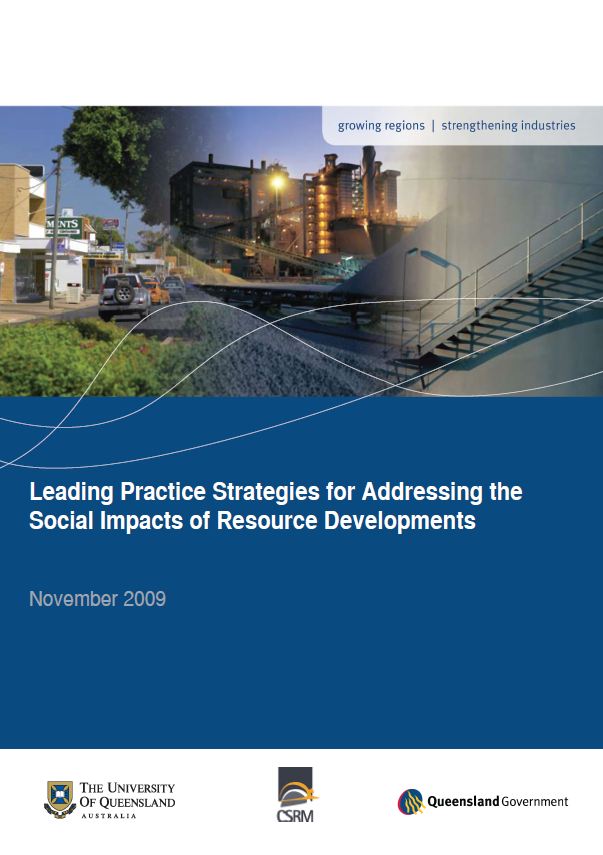Leading practice strategies for addressing the social impacts of resource developments
In September 2008, the Queensland Government introduced the Sustainable Resource Communities (SRC) policy to improve the assessment and ongoing management of the social impacts of resource developments, provide greater coordination and collaboration between stakeholders and address resource governance issues at multiple scales. The policy strengthens the Queensland Government's coordination role, introduces a social impact assessment (SIA) function, improves state?wide and regional coordination through the formation of a partnership group and local leadership groups, emphasises greater links to regional planning, and introduces social impact management plans (SIMPs) to outline the forecasted changes to communities, the agreed strategies for mitigation of impacts, and the responsibility of various parties in relation to the management of social issues. As part of the implementation of this policy, the Queensland Department of Employment, Economic Development and Innovation (DEEDI), in association with the Queensland Resources Council and the Local Government Association of Queensland, commissioned the Centre for Social Responsibility in Mining (CSRM) to undertake research on the leading practice approaches for addressing the social impacts of resource development adopted by other jurisdictions. This research, reported here, considers the promise and pitfalls of such approaches and the applicability to the Queensland context, and provides case studies, advice and principles to assist the development and implementation of the SRC policy in Queensland. Four government jurisdictions are reviewed as case studies. These are South Africa, Canada, New South Wales and Western Australia. In addition, a range of corporate policies were investigated as were the policies of the International Finance Corporation (part of the World Bank group), which has pioneered the use of Social Management Plans. This section provides a summary of the key findings and the relevance to Queensland of each case study. The section also draws a number of principles and opportunities, from the analysis undertaken in the body of the report, to guide the implementation of Social Impact Management Plans and the SRC policy more generally. While there are opportunities to learn from the approaches adopted by other jurisdictions and from leading practice examples in industry, the research has found that the SRC policy itself potentially represents a leading practice example, when benchmarked against other jurisdictions. The introduction of social impact management plans for resource developments has the potential to encourage a more responsive and proactive approach to addressing impacts, if such plans are embedded within management systems at the operational scale. The main body of the briefing paper consists of two sections. Section 1 provides background on the SRC policy, the social challenges experienced in Queensland resource communities and the methodology of the research. Section 2 provides a compendium of strategies and working examples, drawn from the case studies that aim to avoid and mitigate adverse impacts and enhance the positive social impacts of resource developments.
Publisher: Department of Employment, Economic Development and Innovation, Queensland Government & CSRM
Region: Global
Type: Report
CITATION
Franks, D, Fidler, C, Brereton, D, Vanclay, F and P, Clark. 2009. Leading Practice Strategies for Addressing the Social Impacts of Resource Developments. Centre for Social Responsibility in Mining, Sustainable Minerals Institute, The University of Queensland. Briefing paper for the Department of Employment, Economic Development and Innovation, Queensland Government. November. Brisbane.

